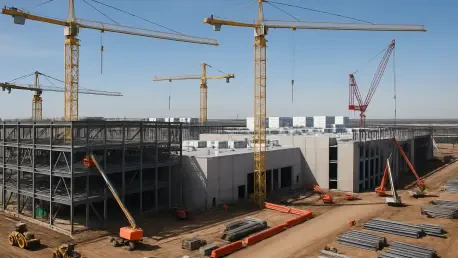In the ever-evolving world of construction, few voices carry the weight of insight like Luca Calarailli. With a deep background in design and architecture, Luca has spent years navigating the complexities of the industry, from traditional infrastructure to cutting-edge technology applications. His passion for innovation and keen understanding of market trends make him the perfect guide to unpack the forces shaping today’s construction landscape. In this interview, we dive into the critical role of infrastructure and data centers in sustaining industry backlogs, the impact of public versus private sector dynamics, and the challenges posed by federal funding uncertainties. Join us as we explore what these trends mean for contractors and the future of construction.
What does the construction backlog represent, and why is it such a vital indicator of the industry’s overall health?
The construction backlog is essentially the amount of work that contractors have under contract but haven’t yet completed, measured in months. It’s a key metric because it reflects both current workload and future revenue potential. A backlog of 8.5 months, as seen in recent reports for September, suggests a steady pipeline of projects, which is a positive sign of stability. Historically, this figure is solid compared to leaner years when backlogs dipped below 7 months, though it’s not at the peak levels of over 9 months we’ve seen during major booms. What it tells us is that there’s a balance—contractors aren’t overwhelmed, but they’re also not scrambling for work. It’s a window into demand and capacity in the industry.
Why has infrastructure construction been the standout sector in adding to contractors’ pipelines over the past year?
Infrastructure has been a lifeline for the industry largely due to sustained public investment. While commercial and institutional sectors have faltered with tighter private budgets, government spending on roads, bridges, and utilities has kept momentum going. Policies like federal infrastructure bills have poured significant funds into these projects, creating a reliable stream of work. Compared to other sectors, infrastructure backlog growth is notably stronger—commercial construction, for instance, has seen declines as businesses hold off on expansions. This disparity shows how much the industry is leaning on public projects to stay afloat.
How do you interpret the mixed signals in contractor confidence, with improved profit margins and staffing outlooks but declining sales expectations?
This inconsistency reflects the uneven terrain contractors are navigating. Profit margins and staffing outlooks are likely improving because of efficiencies—better project management, technology adoption, and a focus on high-value contracts like infrastructure. But declining sales expectations point to worries about future demand, especially in private sectors where investment is cooling. There’s a sense that the current backlog might not be replenished as quickly if private projects don’t pick up. This tug-of-war between short-term gains and long-term uncertainty could definitely influence backlog numbers down the line if confidence continues to waver.
Can you shed light on why public sector construction has outperformed private sector activity this year?
Public sector construction is thriving because of consistent funding and policy support at federal, state, and local levels. Projects like highway expansions, water systems upgrades, and public transit improvements are prioritized as essential, so they don’t face the same hesitancy as private developments, which are more sensitive to economic fluctuations. This year, we’ve seen a lot of backlog growth tied to these large-scale, government-backed initiatives. While private activity—think office buildings or retail—slows amid high interest rates and cautious investors, public works keep chugging along as a stabilizing force.
With the federal government shutdown that began on October 1st, how significant do you think the impact could be on infrastructure backlog?
The shutdown poses a real risk to infrastructure projects that depend on federal funding. While not all public works are affected—many are state or locally funded—those tied to federal dollars could face delays or temporary halts. The slight drop in infrastructure backlog by 1.7 months from the prior report might already reflect early jitters during the survey period. Projects like federally supported transportation or environmental initiatives are most vulnerable. If the shutdown drags on, we could see a more pronounced dip in backlog as contractors wait for clarity on funding.
Why are data centers emerging as such a critical driver of private nonresidential construction right now?
Data centers are booming because of the explosive growth in digital infrastructure needs. With cloud computing, AI, and big data driving demand, companies are racing to build facilities to store and process information. Unlike other private construction areas, like retail or hospitality, data centers are seen as essential investments, even in a cautious economy. The fact that contractors with data center projects report a backlog of 12 months—compared to the industry average of 8 months—shows just how much more work is lined up in this niche. It’s a rare bright spot in private construction.
Looking ahead, what is your forecast for the role of data centers and infrastructure in sustaining the construction industry’s backlog?
I’m optimistic about both sectors continuing to play a pivotal role, though with some caveats. Data centers will likely remain a powerhouse as long as tech demand grows, and I don’t see that slowing anytime soon. Infrastructure, meanwhile, should hold steady if public funding remains a priority, though federal shutdowns or policy shifts could introduce hiccups. The challenge will be balancing these strengths against weaknesses in other areas like commercial construction. If private investment doesn’t rebound, the industry might become overly reliant on these two pillars, which could limit overall growth. I think the next couple of years will test how diversified the backlog can become.









